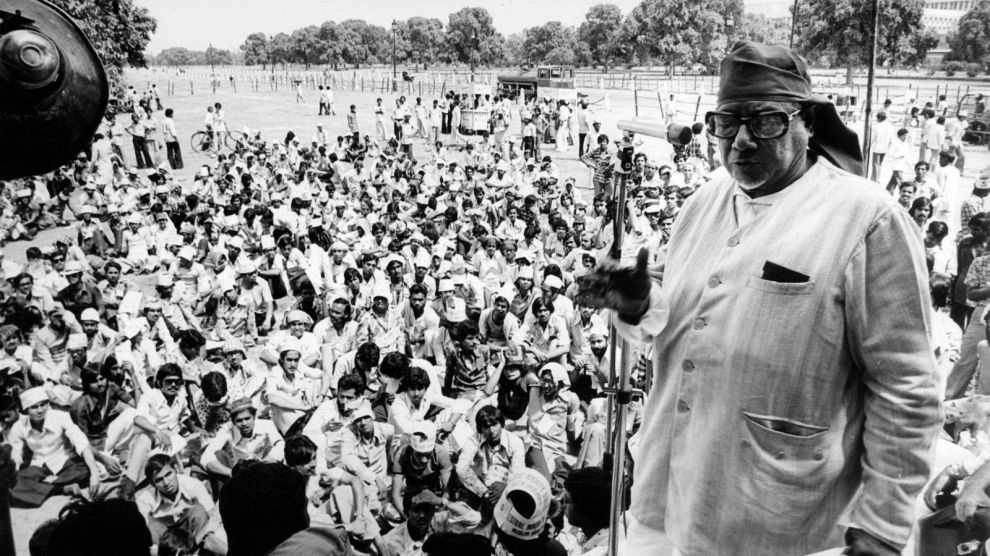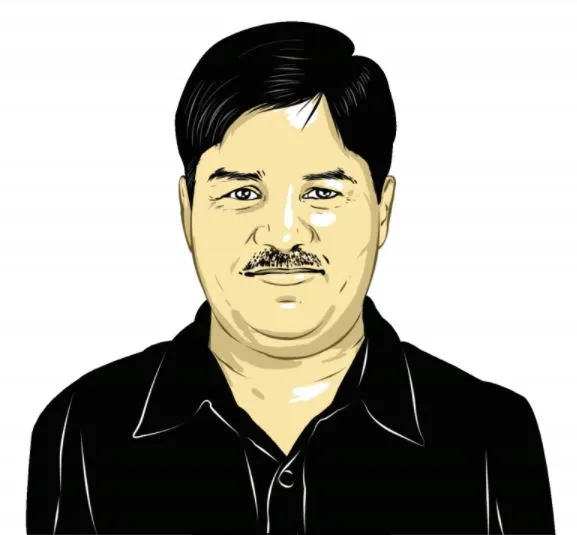Raj Narain: The unlikely hero who couldn’t stop fighting, including his own side
His defeat of Indira Gandhi in court was the immediate trigger for the Emergency. His machinations within Janata Party ensured she returned as PM not long after
 Raj Narain addressing Aligarh Muslim University Rally at Boat Club. Express Archives / Photo by S Paul, 1979.
Raj Narain addressing Aligarh Muslim University Rally at Boat Club. Express Archives / Photo by S Paul, 1979. Of all the words used to describe Raj Narain, few would use “hero”. Most would say “maverick”. Characteristically, even at the zenith of his political career, the man who brought down Indira Gandhi could not help but be both.
Fifty years later, Narain remains among the few people who can claim to have been instrumental in toppling two Indian Prime Ministers – Mrs Gandhi, and then Morarji Desai.
It was the then 57-year-old’s petition that led to the Allahabad High Court setting aside Mrs Gandhi’s 1971 election, leading to her declaring the Emergency. In the 1977 Lok Sabha polls, Narain rounded off this defeat by trouncing Mrs Gandhi personally at the hustings. Come 1979, he conspired with the Congress to install Charan Singh as the Janata Party PM.
A former wrestler from Uttar Pradesh and a heavyset man, who sported thick spectacles and a green cloth tied casually around his head, Narain relished a son-of-the-soil image – as far removed from Gandhi’s Lutyens upbringing as it could get. However, Narain was nobility too, belonging to the Narayan dynasty, the royal family of the erstwhile Banaras State. According to the Union Ministry of Culture website, which features him among the honorees of the 75 years of Indian Independence project, Narain was a direct descendant of Maharajas Chet Singh and Balwant Singh.
By the time Narain’s paths crossed with Mrs Gandhi’s though, he had left that far behind, becoming a follower of Ram Manohar Lohia, committing himself to socialism, virtually disowning his assets and even distancing himself from family, and dedicating himself to “empowerment of the backward and downtrodden”.
Back in 1934, when the Congress Socialist Party carved itself out as a bloc within the Congress, Narain was among those affiliated with it. After Independence, he contested and won in the first two UP Assembly elections, with his mercurial politics already on display. If, in 1952, he won from Banaras City South as a Socialist Party candidate, in 1957, it was from the Kaswar Sarkari seat in Varanasi (Banaras was named Varanasi in 1956) as an Independent. But the one constant was his adherence to Lohia’s principles of “protest” and “agitate”, no matter if they landed him in jail. Apart from the period he spent behind bars before Independence, he served at least 14 years in prison after 1947.
UP was accustomed to images of policemen struggling to remove a protesting Narain as he lay prostrate on the road. It became so common for Marshals to drag him out of the UP Assembly over some protest or another that it came to be called “the Raj Narain style of protest”.
 Raj Narain gestures during a press conference at Shastri Bhawan, Delhi. Express Archive photo by RK Sharma, 1977.
Raj Narain gestures during a press conference at Shastri Bhawan, Delhi. Express Archive photo by RK Sharma, 1977.
In March 1954, addressing the UP Assembly, Narain said that given caste-based discriminations, “It is a historical necessity that the backwards and the weak will organise themselves based on caste. No one can stop this.”
In 1966, Narain decided to move to national politics, and became a Rajya Sabha MP. This, incidentally, didn’t go down well with Lohia. Before Narain’s first term in Parliament ended though, he joined the race against Indira Gandhi from the Rae Bareli seat in the 1971 Lok Sabha polls, taking up the challenge at a time that nobody would. This was Mrs Gandhi’s ‘Garibi Hatao’ slogan election.
On April 24, 1971, days after the results, in which he was soundly defeated by the Congress leader, who repeatedly described him in the campaign as “a hater and baiter of mine”, Narain filed a petition in the Allahabad High Court accusing the newly re-elected Prime Minister of electoral malpractices. Known advocate Shanti Bhushan represented him.
Narain also had the backing of his old mentor and former UP chief minister C B Gupta, who had gone with the anti-Indira Gandhi faction in the Congress split of 1969. However, few took the case seriously at the time.
In 1973, Narain fought a bypoll from the Banka Lok Sabha seat, but again lost.
By 1974, Narain was back in the Rajya Sabha from UP. He also plunged himself into the Jayaprakash Narayan Movement against Mrs Gandhi. On February 17, 1975, with the protests beginning to rattle the Congress government, Narain was among those arrested. He was taken regularly from jail to Bhushan to get an update on his case against Mrs Gandhi.
On June 12, 1975, Justice Jagmohan Lal Sinha of the Allahabad High Court delivered his order, setting aside Mrs Gandhi’s election, while granting her time to move the Supreme Court. She could continue functioning as PM but not participate in proceedings in Parliament. Twelve days later, on the midnight of June 25-26, Mrs Gandhi declared the Emergency.
Narain spent 19 months behind bars. When Mrs Gandhi declared surprise elections on January 18, 1977, Narain again contested against her from Rae Bareli, and defeated her this time by over 55,000 votes.
In her book Indira Gandhi: An Intimate Biography, Pupul Jayakar, who was a close associate of the former PM, wrote: “Raj Narain was a freak on the political canvas. A huge, heavy-shouldered man, a wrestler in his early years, he had emerged from the akharas of Varanasi to political notoriety. He was regarded by some as a buffoon or court jester; by others as a shrewd man of the soil.”
Katherine Frank, the author of Indira: The Life of Indira Nehru Gandhi, described Narain as “the original source of all Indira’s woes”.
 Raj Narain with former prime minister Charan Singh. Express Archives
Raj Narain with former prime minister Charan Singh. Express Archives
Both this shrewdness and this ability to be a troublemaker was again evident when Narain went about helping put together the Janata Party government to replace the Congress after the 1977 results. He was among those who backed Morarji Desai as PM. In the Desai cabinet, he got the Ministry of Health and Family Planning, which he renamed as Health and Family Welfare to distance it from the taint of forced sterilisation drives during the Emergency.
However, Narain soon turned against Desai, accusing the Janata Party government, particularly Desai’s son Kanti, of corruption. He also put the government on the edge by constantly raising the issue of the Jana Sangh members in the Janata Party continuing their ties with the RSS. On July 1, 1978, Narain was removed from the Janata Party Executive and as Union Minister.
Narain then threw in his lot with Desai rival and PM aspirant Charan Singh. Due to differences with Desai, Charan Singh had earlier resigned from the government but had been wooed back with the posts of Deputy PM and Finance Minister in January 1979. Till then, Narain was seen as opposed to Charan Singh, due to the frosty ties between the latter and his mentor C B Gupta. Narain had even coined the term ‘Chair Singh’ for Charan Singh, considering his frequent political somersaults.
But there were more tricks in Narain’s bag, and he now met Sanjay Gandhi to engineer the fall of Desai. In her book on the Emergency, The Indian Express Contributing Editor Coomi Kapoor writes that Sanjay organised meetings between Chandraswami and Narain, in which Narain was persuaded to convince Charan Singh to take Congress support and topple Desai – turning the whole raison d’etre of the Janata Party on its head. Mrs Gandhi was only too happy to join in the humiliating blow to her rivals.
Finally, Narain, along with Janata Party leaders like George Fernandes and Madhu Limaye, withdrew support to Desai and he resigned. But the Charan Singh government that took over, with Congress support, lasted 23 days, with the new PM resigning without even facing a floor test.
Fresh elections were called, and Mrs Gandhi returned to power.
 Former prime minister Indira Gandhi, post her election victory. Express Archive Photo by S Paul
Former prime minister Indira Gandhi, post her election victory. Express Archive Photo by S Paul
In his book All The Janata Men, published during this topsy-turvy time, journalist Janardan Thakur wrote: “Raj Narain never believes in going anywhere unless he can create a storm around himself. Legislature and Parliament are just other akharas for him to wrestle in.”
Sure enough, Narain was not done. In the 1979 Lok Sabha polls, he delivered another surprise, contesting not from Rae Bareli but Varanasi, against the Congress’s Kamalapati Tripathi – who was a fellow follower of socialist stalwart Acharya Narendra Dev. Before he filed his nomination, Narain even met Tripathi to seek token money to file his nomination and to get his blessings, given their common “guru”. Narain lost.
Later, Charan Singh too would feel the sharp edge of Narain’s U-turns. After ties between them worsened to the extent that Singh sacked him from his Lok Dal in April 1980, Narain travelled the breadth of UP to take on Charan Singh in the 1984 Lok Sabha polls from his turf of Baghpat. An Independent, Narain secured 7.14% of the votes and came third.
Two years later, on December 31, 1986, Raj Narain – by then referred to by his followers fondly as ‘Lok Bandhu’ – passed away.
In their book Lok Bandhu Raj Narain, authors Dheerendra Sriwastava and Lalji Rai quoted Lohia as saying: “As long as a person like Raj Narain is in this country, dictatorship can’t grow here.”
Charan Singh himself would acknowledge the impact of his sometime comrade in Dr Yugeshwar’s book Apatkal Ka Dhumketu (Emergency’s Comet). “The political world,” he said, “can never forget Raj Narain.”




